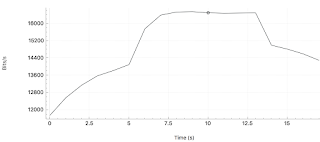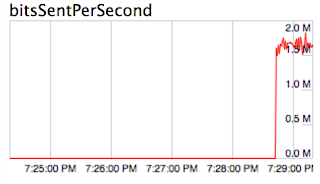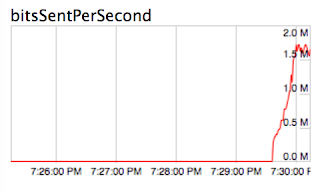Bandwidth Estimation in WebRTC (and the new Sender Side BWE)
2017-09-06 15:08
399 查看
Bandwidth Estimation in WebRTC (and the new Sender Side BWE)
January30, 2017Bandwidth estimation is probably the most critical component in the video engine of WebRTC. The bandwidth estimation (BWE) module is responsible for deciding how much video* traffic you can send without congesting the networkto prevent degradation of the video quality. In the past bandwidth estimation algorithms used to be very rudimentary and based mostly on packet loss. Basically we used to start increasing slowly the video bitrate until we detected packets being lost. To detect the packet lossyou use the standard RTCP feedback mechanisms where the receiver side reports packet loss periodically using RTCP Receiver Report (RR) messages.Modern bandwidth estimation algorithms are more advanced and try to detect congestion before it is bad enough to make routers discard packets. These algorithms predicts congestion analyzing the delay between packets. The idea is that when youstart having some congestion, the buffers in the routers will start filling and the delay will be more variable. Some popular examples of these algorithms are GoogleCongestion Control (the one used in WebRTC), SCReAMand SPROUT. If you want to read more about the history and status of congestion control standards you can read this very interestingpost from Randell Jesup.From the very beginning of WebRTC, the media engine (that is built by Google but included in both Chrome and Firefox) was based on the concept of remote bandwidth estimation. As explained before the receiver of the traffic analyzes the inter-packetdelay and generates an estimation of the available bandwidth that is reported back to the sender using RTCP messages with a new message type that was defined for this purpose: REMB.Another detail of WebRTC implementation is that the sender will use not only this bandwidth estimation received in the REMB packet but also the packet loss feedback to decide the final value of the target video bitrate to be sent.Sender pseudocode (send_side_bandwidth_estimation.cc): onFeedbackFromReceiver(lossRate): if (lossRate < 2%) video_bitrate *= 1.08 if (lossRate > 10%) video_bitrate *= (1 - 0.5*lossRate) if (video_bitrate > bwe) video_bitrate= bwe;The nice consequence of that implementation is that it reduces bitrate quickly when overuse is detected while slowly increasing bitrate when no congestion is detected.But in recent versions of Chrome this has changed and now the whole bandwidth estimation logic happens in the sender side. The basic detection of congestion is not very different from how it was before and the sender needs delay informationfrom the receiver side in order to be able to estimate the available bandwidth. This is accomplished with two new mechanisms/protocols:1. Transport wide sequence numbers header extension: All the video RTP packets carry an extra 4 bytes in the header to include a sequence number. This is negotiated in the SDP with the following line:a=extmap:5 http://www.ietf.org/id/draft-holmer-rmcat-transport-wide-cc-extensions-01 Note: the idea of this new sequence number is to be able to use a single counter for both audio and video but Chrome still doesn't use it for audio, so I think it is not very useful yet.2. Transport Feedback: The receiver side sends periodic feedback to the media sender with information about the packets received and the the delay between them. To do this the receiver uses a new RTCP Packet(Transport Feedback). This feature is negotiated in the SDP with this line including the new RTCP feedback message:a=rtcp-fb:100 transport-cc When looking at how is this transport feedback packet looks like it is funny to realize that there is a specificationwith Google's proposal and an official standardization proposal but the only source of truth is the realimplementation in the source code.This RTCP feedback is sent every 100 msecs by default but it is dynamically adapted to use 5% of the available bandwidth (min value is 50 msecs and max is 250 msecs).The format of this new RTCP packet is very concise to minimize the size, including grouping packets in chunks, storing numbers as base + diff or reducing granularity to 0.25 msec intervals. I did a simple test and even with these improvements it was still using16Kbps sending feedback packets every 50 msecs (Figure 2). |
| Figure 2: Bandwidth used in RTCP Transport Feedback Messages |

 Who is working on this and what is the status? Sender side bandwidth estimation is the default in Chrome 55 but this is still work in progress and we should expect many changes. The official standardization is happening in IETF in the RMCATgroup but most of the implementation available in Chrome is Google's own version of the in-progress specifications for algorithms and feedback protocols. * Chrome is planning to use bandwidth estimation also to decide the audio bitrate to send (Planned for version 58).You can follow me in Twitter if you are interested in Real Time Communications.
Who is working on this and what is the status? Sender side bandwidth estimation is the default in Chrome 55 but this is still work in progress and we should expect many changes. The official standardization is happening in IETF in the RMCATgroup but most of the implementation available in Chrome is Google's own version of the in-progress specifications for algorithms and feedback protocols. * Chrome is planning to use bandwidth estimation also to decide the audio bitrate to send (Planned for version 58).You can follow me in Twitter if you are interested in Real Time Communications.
相关文章推荐
- An Overview Of The New Services, Controls, And Features In ASP.NET 2.0
- The differences between new(delete) and malloc(free) in c/c++
- New influence in American Life -- The roles of man and woman changing
- What's New in the C# 3.0 Language and Compiler
- Effective C++ Item 16 Use the same form in corresponding uses of new and delete
- WebRTC in the real world: STUN, TURN and signaling
- How to Monitor Your Network Usage in Windows 8 (And Prevent Paying For The Extra Bandwidth)
- Developers’ Must-have: the new Microsoft All-In-One Code Framework Sample Browser and 3500+ samples
- WebRTC in the real world: STUN, TURN and signaling
- Setting the Reply-To Header in an Email using CDONTS.NewMail Object and CDO Message
- Give the New PIVOT and UNPIVOT Commands in SQL Server 2005 a Whirl
- Puffy and the Cryptonauts: What's New in OpenBSD 4.3
- Common problems and solutions in the new brick-making equipment
- The article discusses a couple of new features introduced for assemblies and versioning in Visual Studio 2005.
- The Difference of Class.forName()、Class.forName().newInstance() and New in Java
- Drag and Drop: New Data Transfer Capabilities in the JavaTM 2 Platform, Standard Edition (J2SETM), version 1.4
- [EffectiveC++]item16:Use the same form in corresponding uses of new and delete
- Item 16: Use the same form in corresponding uses of new and delete.(Effective C++)
- Developers’ Must-have: the new Microsoft All-In-One Code Framework Sample Browser and 3500+ samples
- Out With the Old and in With the New
